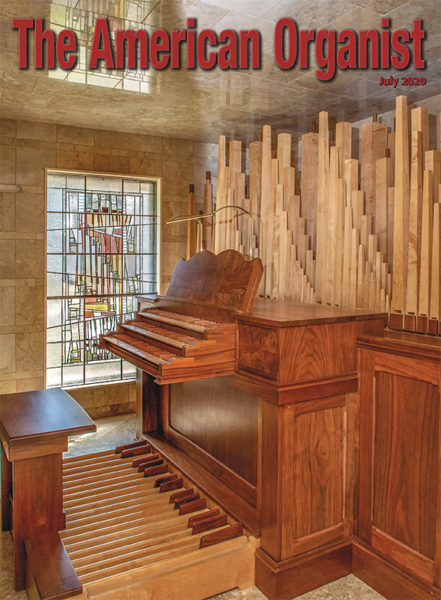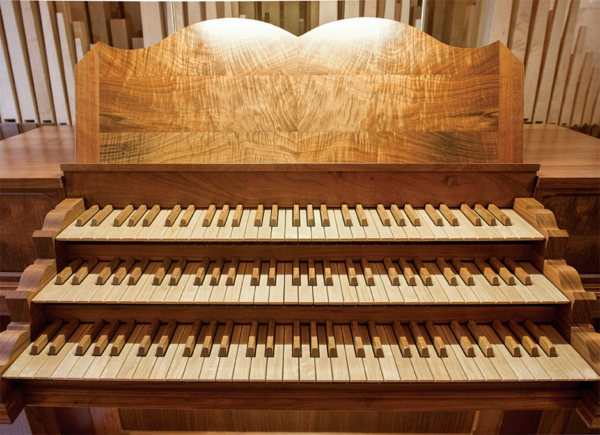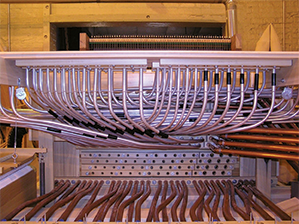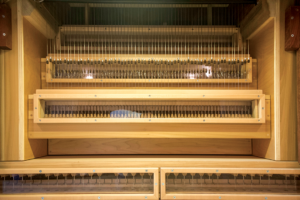Irvin Boudreaux
Practice Organ
Baton Rouge, Louisiana
Nolte Organ Building • Milwaukee, Wisconsin
By John M. Nolte

Every successful organ project begins with a dream or vision. The maxim attributed to Thomas Edison is also true: “Vision without execution is just hallucination.” Irvin Boudreaux’s vision of his own practice instrument began when he was a private student of Warren Hutton at the University of Alabama, Tuscaloosa. The most popular practice organ on campus was the 1974 Holtkamp two-manual and pedal tracker with three 8′ ranks: Manual I Rohrflöte, Manual II Copula, and Pedal Pommer. There were no stops or couplers, just 154 pipes to help you learn your music. Irvin thought about this off and on for a number of years. Playing three-manual instruments got him thinking about a larger instrument—one more manual and one more rank. Over the years he shared his ideas with a number of builders of trackers. Each one modified his vision in order to build his instrument their way.
I met Irvin at an organbuilders’ convention. He liked our display of wood pipes, including several nontraditional samples—a Spitzgedeckt, a Rohrflute, a Violin, and overblown and double overblown Gedeckts. Could we make pipes for his practice organ if he built it? Of course. Then he asked if we could do a tracker instrument with no stops or couplers. That would be easy enough, I said, and I started to imagine a complex network of wires and valves and squares. That wasn’t what he had in mind. He didn’t want rollerboards or lots of tracker squares.
We have a saying in our shop: “In the design stage, the number of options is infinite.” Irvin’s requirements eliminated most of our options, making things much easier.

Small portative organs with one rank of pipes and a short compass have the pallets in line with the key spacing, and everything can be made to fit. Going to a full compass with large bass pipes would need some adaptation. And then Irvin requested that the pipe arrangement be in major thirds, since that makes for better pipe speech.
These conversations did not happen at just one dinner at just one convention. The vision germinated over a period of two or three years, and the breakthrough came when we suggested offsetting the pipes as we normally do when the bass pipes or facade pipes are too large to fit on the main chest. In this case, the offset scheme was a little extreme. All 61 pipes in each rank would be offset. With the valves on the key centers, the air would run through tubes to each pipe. Once this concept was in place, we were commissioned to draw up the design and asked to quote pipes for two manuals and pedal.
Even in the design stage, we are still working with a vision, but when the client starts to commit resources to a project, his vision is on the road to becoming a reality. The first pipes we made were three octaves of Rohrflutes. We also made a three-octave chest to test the action concept. Since the chests had to be below the keys, we opted to have the tail of the key lift the pallet to play the note. This meant that gravity would hold the pallet closed when the key is at rest. With no pallet springs at all, our action played the pipes, but the repetition rate was a little too slow for rapid playing. A very light spring was added, and the result felt just like a good harpsichord action. When Irvin came to test out the action, comparing it to many of the finest organs in America and Europe, he pronounced it the best he had ever played!

Irvin still had to choose between two manuals or three. Cost was a factor, as was the practical problem of fitting three chests with pallets between the keys and pedals. A larger issue was the ability to get the right sounds out of wood pipes. When the Internet became a useful tool for ordinary people to share information, I had acquired digital photocopies of the documentation of the scales of the 1610 Compenius organ from a Danish museum. However, all of the notes were in Danish. Fortunately, on the web page of the Mechanical Music Digest, I ran across Matthew Caulfield, whose hobby was translating old Danish manuscripts. Now these scales are available in spreadsheet form with notes in Danish, English, and German, the latter translation graciously provided by Angelika Hesse, who was with Giesecke & Sohn at the time. The scales for Irvin’s Gemshorn and Principal are based on the Compenius scales. When we held an American Institute of Organbuilders midyear seminar on voicing wood pipes, we invited as one of the presenters Mads Kiersgaard, since he restored the Compenius organ in 1985. Irvin was also invited to attend. When he heard the sound of the Compenius Principal, the vision was refined, including the invisible sphere of sound. The Rohrflute on Manual I has a stopped bass, and then the stoppers are drilled out to form the chimney starting at middle C. There is a treble ascendency, so it functions well for solos and can accompany itself. The Principal on Manual II is voiced evenly throughout the compass. The Gemshorn on Manual III is voiced with a hornlike quality distinct from the Principal. Its bass octave is the Spitzgedeckt offset to the left. The Pedal Bourdon is voiced with a full fundamental. It becomes slightly quieter in the treble range.
The case was the final aspect we designed. Irvin wanted the entire visible organ to be furniture-quality maple and walnut. In the 1970s, I had been given a walnut tree. Rather than cutting it down and leaving a stump, I dug out the stump with the trunk of the tree and had a local sawmill cut it into boards. Walnut stump wood is highly figured, and the grain patterns reflect the stresses placed on that part of the tree as it grows and leans one way or another. This wood is featured on the music rack and the doors in front of the storage compartments on either side of the keyboards. We also had in stock several very wide walnut planks. These helped us choose a frame and panel case style with each panel made of a single wide board. The manual keyboards were made by Laukhuff, with walnut cheeks and sharps and maple naturals.
We held an open house in our Milwaukee shop before the organ was moved to its Baton Rouge home. Irvin catered the open house. His vision had become a reality. Now that it is in his home, where the visual and aural beauty invites him to sit down and play, Irvin reports:
Playing this instrument is pure joy. The organist faces the pipes, which are literally a couple feet away from the player, and the sound reaches the ear immediately . . . which allows the organist to hear every nuance in the pipes’ speech and his or her touch. With the pipes arranged in major thirds, the sound appears to come from all directions (which it does), and soon you realize phrasing and the resolution of technical problems become second nature.

The biggest problem first-time players have is that everything you put into the instrument is immediately sent back to you . . . including mistakes! Never have I played any instrument that helped you clean up your technique so quickly.
In preparing this article, I looked into the Holtkamp practice organ at Tuscaloosa for the first time. The 1974 date surprised me. I began working at American Organ Supply Company in Milwaukee in the fall of 1973. At that time, American Organ supplied all of the wood pipes that Holtkamp used in their organs. One of my first experiences in making wood pipes was a small part of the inspiration for Irvin’s vision for his own special instrument. Small world.
John M. Nolte is the founder and owner of Nolte Organ Building in Milwaukee, Wisconsin. Website.
All photos, including the cover, by John Balance, Baton Rouge, La., except as noted.
Postscript
What if this is not exactly your vision? The organ action is modular so that it can be configured for one, two, or three manuals. We have a preliminary design for a one-manual and pedal continuo organ of up to twelve ranks portable enough to be moved in an elevator from a lower chapel to the main church. The action can be used for any appropriate combination of ranks. The casework is custom and can be more ornate, simpler, or even nonexistent. Irvin has another vision for a three-manual and pedal organ in a French Classic style of about 50 ranks with the console out from under the organ, where the organist can hear better. That requires two tracker squares for each key, but again, no rollerboard. Another client had a much different vision. You can see it at BlackstoneOrgan.org.